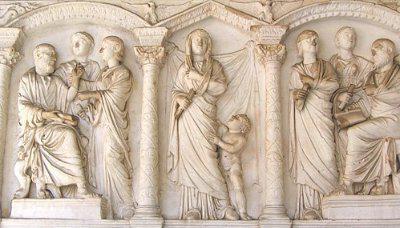In the modern world, the issue of guardianship and guardianship under no circumstances does not lose its relevance. In any society there live individuals who are legal (endowed with rights), but do not have the necessary level of understanding, as well as mature enough will to be able to independently manage their own affairs (considered incompetent). This should include minors and people with special needs. It is interesting that, in accordance with old views, this category included wasteters and, which today seems very strange, women. Which are known today institutions of guardianship in the Roman law? How did they form? What was behind it?
Historical information

Guardianship and trusteeship in Roman law did not appear immediately. At first, it was assumed that all these individuals were under the control of certain families. It is clear that there have never been special questions regarding their protection. Why? Firstly, in accordance with the old law, they were not endowed with property complexes at all; secondly, they considered their paterfamilias their only protection.
It is another matter if the cited social categories were not endowed with such a family protection of natural nature. Such, as a rule, belonged to the number personae sui juris. It was because of them that the institutions of guardianship and trusteeship in Roman law began to form. These served as excellent protection of the artificial direction. So, a surrogate of natural protection was created. It is important to note that even today the key idea and part-time goal of this institution has not changed. So, guardianship and trusteeship in Roman law, the essence of which is to protect certain categories of people, are studied to this day. It is necessary to add that in the modern world Roman law serves as a good model in relation to the legal systems of other states. Therefore, it is very important to have in-depth knowledge on the issue considered in the article.
How did the institution of guardianship and trusteeship develop? Legal Notion

What is custody and guardianship in Roman law? Briefly The answer was given in the previous chapter. However, before examining this issue in detail, it is necessary to understand what legal capacity and legal capacity are in Roman private law. So, by legal capacity it is customary to understand the exceptional ability of an individual to fulfill certain duties and have specific rights.
Before proceeding to consider the institution of guardianship and trusteeship, you should understand the concepts of legal capacity and legal capacity in Roman private law. By the way, during the period of tsarist rule, Rome lawyers observed differences between homo himself - a physical person with his own desires, will and type of character, and, accordingly, his civil law personality - persona singularis.
Thus, the distinguishing feature of Roman civil law from modern civil law is the lack of birth of an individual in order to recognize him as a legal entity. To recognize a person as absolutely legal, it was necessary to be in a special state called status. In accordance with this provision, he should have some status categories: citizenship, freedom and family. In other words, the individual needed to be a citizen of Rome, free and completely independent.It is important to note that the loss of at least one of the presented statuses indicated the termination or change in volume in relation to legal capacity.
Legal capacity in Roman law

Describing categories such as guardianship and trusteeship (Roman law), comparison with modern civil law speaks of the unity of the basic idea and, of course, the goal. One way or another, it is customary to understand competency directly as a person’s ability to be vested with certain rights through his own actions and, accordingly, form certain legal duties for himself. In addition, he needs to be responsible for the offenses if this provision is relevant.
It is important to note that in the sources of Rome the concept under consideration was absent altogether. Nevertheless, from the most ancient times, the Romans noted that it is only those individuals who can guarantee their reasonable behavior have the opportunity to independently be responsible for their own actions of an unlawful nature, as well as have certain rights. So, far from all people were able, due to the state of their own psyche, age category and other parameters, to adequately assess the current situation, choose the right measure of their behavior in the legal aspect, and also fully recognize the corresponding consequences. How did it come about guardianship and trusteeship in Roman law?
It was in such cases when (due to deficiencies in the psychology, physiology or human physics of a legal entity) there were no absolute guarantees of adequacy, legal capacity was subject to exclusion or some restrictions. What compensated this shortcoming? Right! They came to the rescue guardianship and trusteeship in Roman law. Training The "project" was carried out long enough, right !?
Classification of individuals

In accordance with Roman law, absolutely all people were subject to the following classification:
- Individuals were considered individuals from birth to seven years of age. It is clear that they were incapacitated. In relation to those relevant guardianship and trusteeship in Roman law. Why? Because absolutely all actions were performed directly by the guardian.
- Persons from childhood were persons from seven years old up to puberty. Thus, the final framework for girls was established at the age of twelve, and for boys this number of years was fourteen. It was believed that they could already "desire and understand." That is why, through law, they recognized limited legal capacity. As children, they had the right to perform certain actions that improve their position in the property aspect, but could not practice those actions, the result of which was the deterioration of property status. In other words, minors coming out of childhood had the opportunity to acquire rights, but could not form duties for themselves. So, guardianship and trusteeship in Roman law briefly describes that this category of individuals needed their own empowerment. That is why they needed the help of a guardian.
- Upon reaching adolescence, individuals acquired absolute legal capacity. So, they no longer needed guardianship and trusteeship, in Roman law regarded as protecting a legally incompetent population.
Legal content of custody and guardianship in Roman law

Under guardianship in the legal aspect, it is necessary to understand the authority allowed by civil law in relation to a free person in order to endow protection to someone who, due to the above reasons, is not able to provide this kind of protection independently. So, describing a category such as guardianship in the Roman law order talks about the lack of juvenile legal capacity, which is compensated before he reaches adulthood by taking part in his transactions a mature man, called a guardian, the presence of which is mandatory. It is important to note that in Roman law, the formation of a woman under guardianship was taken for granted, as she was among the frivolous people.
In order to carry out a legally significant action, a person under guardianship must receive approval, as well as the approval of the act directly from the guardian. That is why the acting individual is primarily considered the guardian. Guardianship in the Roman law, meaning in relation to these categories, it means that a woman, already an adult, needs a guardian exclusively for the formation of a will, alienation or the establishment of usufruct. It is important to recall that, unlike her, every action to establish obligations related to a child is controlled by a guardian.
Logical addition
By the way, having described a category such as guardianship and trusteeship (Roman law), the comparison speaks of the appearance in this case by a guardian of a representative of the fair sex of a person other than an agnatic relative. So, his role is endowed with a symbolic character in the corresponding era. It is because of this feature that Guy criticizes the belief in female frivolity that is so prevalent in society. He claims that they need protection in order to avoid fraud. In reality, women who, unfortunately, were not available to transactions of a civil nature without the approval of a guardian, as a rule, made quite pragmatic decisions.
Thus, in the story of Livia about the events of the second century BC, the freed woman expresses a desire to ask the magistrates for a guardian after her death directly (while she was no longer under guardianship) to form a will. So, practice shows that guardianship in the Roman law, establishment of these categories testifies to the appointment as the main goal of directly compensating for one or another lack of legal capacity, which is determined in a formal way. In turn, the grounds that come directly from the characteristics of an individual of a psychic nature, placed under the guardianship procedure, are secondary.
Functions of a Guardian in Roman Law

It is with the conclusion given in the previous chapter that the functional difference of the guardian is directly dependent on the age category of the ward. Describing a category such as guardianship and trusteeship in Roman law concept talks about the need for the guardian to take over the general management of the baby’s property complex, as well as in the absence of a ward when even all the affairs of the fair sex are at the guardian’s place. In such circumstances, there is a division of ownership that is functional in nature. In this case, both the static and the abstract owner of the property complexes is considered to be the guardian, and the guardian is still managing and managing them. It is important to add that the rights of the latter are in reality determined solely by the failure of the ward. Private Guardianship in Roman Private Law they say that when he reaches the age of majority, in any case, he does not need the services of a guardian and becomes the full owner of his property without formalizing any formal acts regarding the transfer of rights.
The logical nuance is that in the event of the death of a guardian, his heirs are not endowed with any rights in relation to the property complexes of the guardian. They only retain responsibility.
Guardianship and trusteeship in Roman law. Types of custody
The role of the guardian in Roman law depends mainly on the age category of the ward. For example, the affairs of children under seven years of age are decided by a guardian who knows how to conduct them in appropriate conditions for the child's age. Children from seven to fourteen, in turn, include a guardian, from whose duties, for example, net acquisition transactions will be excluded, because adolescents are able to cope with such independent way. In addition, a twelve-year-old child has enough knowledge to manage his own affairs. However, individuals of this age category are more and more often objects of exploitation. That is why the authorities announced a special law criminalizing the prosecution of those who dared to take advantage of the inexperience of adolescents who have reached the age of majority, but who have not reached the age of twenty-five. By the way, subsequently, the effect of this law expanded until the implementation of transactions of an inexperienced nature. Describing a category such as guardianship and trusteeship in Roman law says that an adult who has not yet turned twenty-five years old, asking for the appointment of a guardian to him, becomes somewhat limited in relation to his own activities. So, for the effectiveness of his transactions, which potentially reduce property, the official consent of the trustee is required. By the way, this kind of document can be executed both before and after the transaction.
Additional facts
The previous chapters described in detail those categories such as guardianship and trusteeship in Roman founding law. In accordance with these provisions, a very interesting fact was established that young people under twenty-five years of age did not have the right to marry or to make a will without the consent of the trustee (completely incommensurable with modern civil law!). In addition, it is surprising that custody in relation to the fair sex lost its relevance quite early. So, by the end of the republic, women had the right to independently participate in business relations (finally!). Only a few acts of civil law, among which an active role was played by participation in the legal process and the alienation of property complexes, needed to be endowed by the woman with the consent of the guardian. By the way, even such restrictive measures at the beginning of the classics period were perceived as unnecessary (which is very correct). Thus, in the first half of the first century, the main type of custody of the fair sex was officially abolished - custody of the nearest agnates, after which the almost no use of custody by the will of the father or husband was excluded.
However, this fact was not at all equivalent to the absolute equalization of women with men, how could it be otherwise !? So, a huge number of legal functions turned out to be closed to women. They did not have the right to occupy positions of a public nature, speak in court for other persons, and also be considered guardians. An exception to the last paragraph was made by mothers and grandmothers, who were directly guardians of their own children and grandchildren.
Conclusion

It should be noted that during the times of ancient civilization, the guardianship procedure was established, as a rule, exclusively in the interests of those persons who were considered to be the closest heirs to the ward at the legislative level. The main purpose and idea of guardianship was to protect the property of the ward in accordance, of course, with the interests of his heir.
Along with this, state control in relation to guardian activities gradually developed.So, special attention was paid to the system of claims directly to the guardian in the event that he did not provide a report on the conduct of affairs of the ward (or provided incomplete documentation) or negligently conducted his affairs.
In view of the foregoing, an interesting conclusion can be drawn that the institution of guardianship, both in Roman law and in civil law, primarily aims at nothing more than compensation for the defect of an individual's incapacity. By the way, this defect is almost always determined in a formal way. In turn, those justifications that come directly from their mental characteristics of a particular person and are placed under guardianship are, one way or another, secondary. It is important to add that the functional classification of guardianship, which, as noted above, is completely dependent on the age category of the ward, is consistent with this conclusion.
Regarding the article, it can also be explained that guardianship changed in relation to its very essence and even in the later imperial law assumed approximately the form that it has in modern legislation.